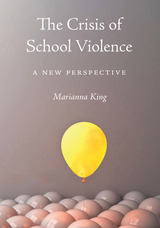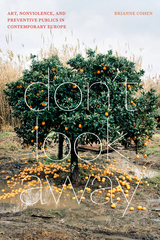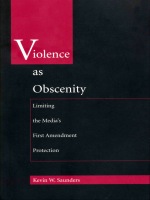4 books about Violence in mass media

The Crisis of School Violence
A New Perspective
Marianna King
Michigan State University Press, 2020
The Crisis of School Violence is the only interdisciplinary book about school violence. It presents a broad and in-depth approach to the key questions about why bullying continues at an unprecedentedly high rate and why rampage school shootings continue to shock the nation. Based on extensive research, The Crisis of School Violence investigates human nature and its relation to aggressive behavior, with a special focus on the culture of violence that predicates school violence (including rampage shootings) and perpetuates industries that profit from violence. Marianna King presents the considerable psychological and neuroscientific research that investigates the effects of violent entertainment media on the brain and, subsequently, on behavior, which clearly reveals a causal connection between exposure to violent electronic entertainment media—especially violent video games—and increased aggressive and violent behavior. The book also reveals a more specific connection between exposure to violent video games and rampage school shootings. Ultimately this volume is a call to action that includes recommendations for parents, teachers, decision makers, and citizens alike.
[more]

Don't Look Away
Art, Nonviolence, and Preventive Publics in Contemporary Europe
Brianne Cohen
Duke University Press, 2023
In Don’t Look Away Brianne Cohen considers the role of contemporary art in developing a public commitment to end structural violence in Europe. Cohen focuses on art activism of the early twenty-first century that confronts the slow violence perpetuated against precarious peoples. Exploring the work of German filmmaker Harun Farocki, Swiss artist Thomas Hirschhorn, and the art collective Henry VIII’s Wives, Cohen argues that their recursive art practices offer a more sustained counter to the violence undergirding the public sphere than do artworks premised on immediate rupture. Their art reflects on a variety of flashpoints of violence and vulnerability in Europe, from the legacy of the Holocaust to Islamophobia and rising anti-immigrant sentiment. Because this violence has often cultivated fear-based publics, Cohen contends that art must foster ethical and civil relations between strangers across physical and virtual borders. In contrast to art-critical practices that privilege direct action in contemporary art activism, Cohen advocates for the imaginative, messier, often more elusive potential of art to change mindsets and foster a nonviolent social imaginary.
[more]

Don't Mention the War
Northern Ireland, Propaganda and the Media
David Miller
Pluto Press, 1994

Violence As Obscenity
Limiting the Media's First Amendment Protection
Kevin W. Saunders
Duke University Press, 1996
This timely and accessible volume takes a fresh approach to a question of increasing public concern: whether or not the federal government should regulate media violence. In Violence as Obscenity, Kevin W. Saunders boldly calls into question the assumption that violent material is protected by the First Amendment. Citing a recognized exception to the First Amendment that allows for the regulation of obscene material, he seeks to expand the definition of obscenity to include explicit and offensive depictions of violence.
Saunders examines the public debate on media violence, the arguments of professional and public interest groups urging governmental action, and the media and the ACLU’s desire for self-regulation. Citing research that links violence in the media to actual violence, Saunders argues that a present danger to public safety may be reduced by invoking the existing law on obscenity. Reviewing the justifications of that law, he finds that not only is the legal history relied on by the Supreme Court inadequate to distinguish violence from sex, but also many of the justifications apply more forcefully to instances of violence than to sexually explicit material that has been ruled obscene. Saunders also examines the actions that Congress, states, and municipalities have taken to regulate media violence as well as the legal limitations imposed on such regulations by the First Amendment protections given to speech and the press. In discussing the current operation of the obscenity exception and confronting the issue of censorship, he advocates adapting to the regulation of violent material the doctrine of variable obscenity, which applies a different standard for material aimed at youth, and the doctrine of indecency, which allows for federal regulation of broadcast material.
Cogently and passionately argued, Violence as Obscenity will attract scholars of American constitutional law and mass communication, and general readers moved by current debates about media violence, regulation, and censorship.
Saunders examines the public debate on media violence, the arguments of professional and public interest groups urging governmental action, and the media and the ACLU’s desire for self-regulation. Citing research that links violence in the media to actual violence, Saunders argues that a present danger to public safety may be reduced by invoking the existing law on obscenity. Reviewing the justifications of that law, he finds that not only is the legal history relied on by the Supreme Court inadequate to distinguish violence from sex, but also many of the justifications apply more forcefully to instances of violence than to sexually explicit material that has been ruled obscene. Saunders also examines the actions that Congress, states, and municipalities have taken to regulate media violence as well as the legal limitations imposed on such regulations by the First Amendment protections given to speech and the press. In discussing the current operation of the obscenity exception and confronting the issue of censorship, he advocates adapting to the regulation of violent material the doctrine of variable obscenity, which applies a different standard for material aimed at youth, and the doctrine of indecency, which allows for federal regulation of broadcast material.
Cogently and passionately argued, Violence as Obscenity will attract scholars of American constitutional law and mass communication, and general readers moved by current debates about media violence, regulation, and censorship.
[more]
READERS
Browse our collection.
PUBLISHERS
See BiblioVault's publisher services.
STUDENT SERVICES
Files for college accessibility offices.
UChicago Accessibility Resources
home | accessibility | search | about | contact us
BiblioVault ® 2001 - 2024
The University of Chicago Press









